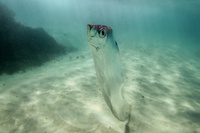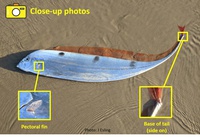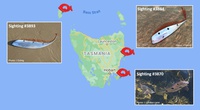Act fast if you see a rare ribbonfish!
Redmap Team, 10 Feb 2021.
If you are lucky enough to see a ribbonfish, you can help scientists collect some very valuable data on them.
This summer has seen some interesting and rarely seen species being reported to Redmap. In particular, three rare sightings of ribbonfish really caught our eye!
Ribbonfishes (also known as dealfishes) are part of the Trachipteridae family which is made up of about 10 species globally. Their relatives include the spectacularly coloured Southern Spotted Opah (Lampris australensis) and the 8m+ long Oarfish (Regalecus glesne), which has been a likely source of ‘sea serpent’ sightings for centuries.
Ribbonfishes are rarely encountered. They usually inhabit oceanic and deep-sea environments, but are occasionally observed in shallow water, which has enabled our Redmappers to grab some great photos!
Scientists still have a number of questions about the taxonomy and distributions of species in this group, particularly the Trachipterus, which has at least two known Australian species. Rarity of samples, historical misidentifications, and changing morphology with age (e.g. body shape and colouration) have contributed to this…
But that’s where you might be able to help!
Our friends at CSIRO’s Australian National Fish Collection are interested in sightings of ribbonfishes. These fishes have been encountered from 30cm to 2m long, with silver-coloured flanks and often reddish coloured fins. Juveniles may also display black spots, fin extensions and an upturned, fan-like tail.
If you see one alive, please take a clear photo and submit it to Redmap as a record. If you come across a dead one, please take these steps:
- Take a clear photo of the whole animal, ideally with a scale (e.g. ruler or something else of known length that can be measured later)
- Take close up photos of the pectoral fin spread out (to count individual fin rays) and the base of tail (to see small spines) – see annotated photo below
- If you are able to retain the fish, please wrap it in glad wrap after taking photos (to reduce freezer burn), put it in a freezer and CSIRO will get in touch
- As soon as possible please contact enquiries@redmap.org.au with details of the sighting and a photo, which we will forward to the CSIRO Australian National Fish Collection or the most relevant state museum collection
- Add as a Redmap sighting and we’ll map it on the website!
Learn more about the CSIRO Australia National Fish Collection HERE.














